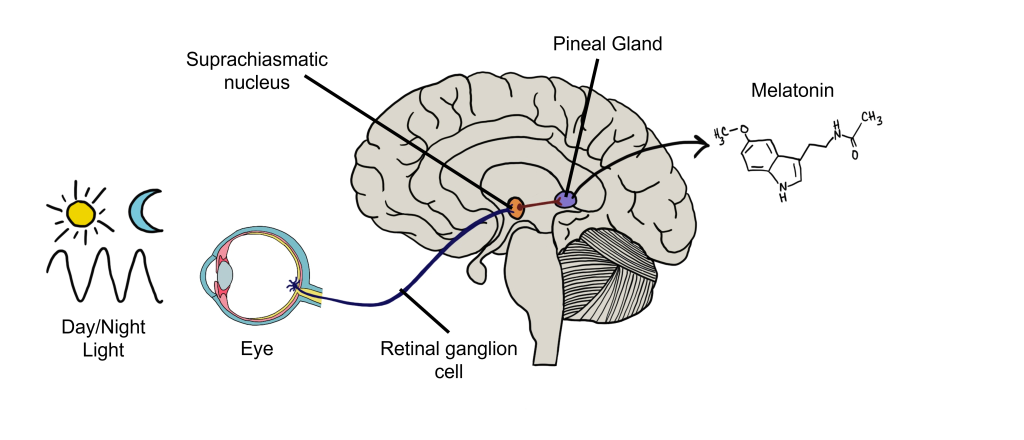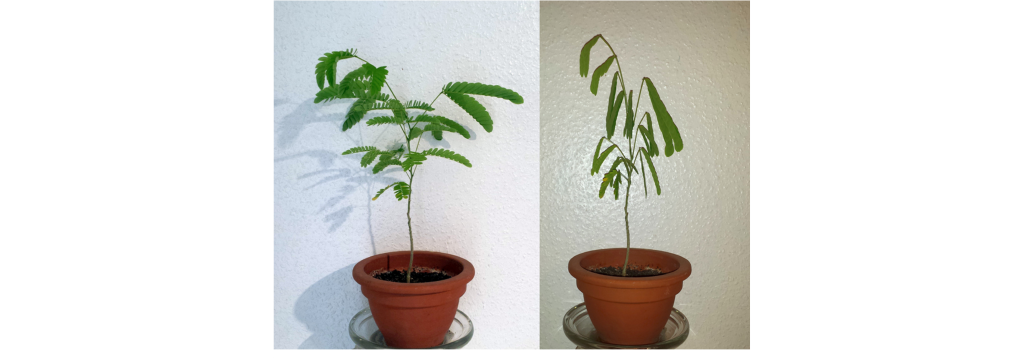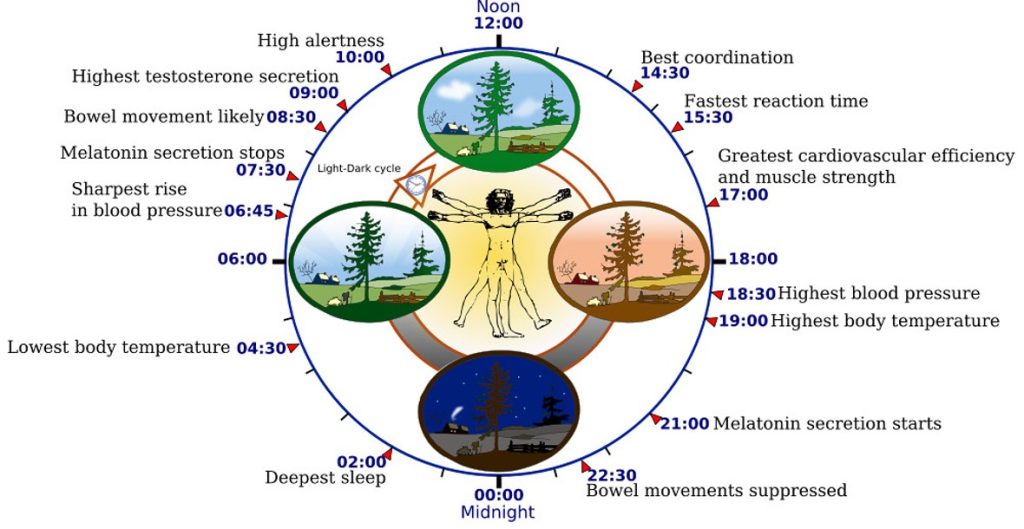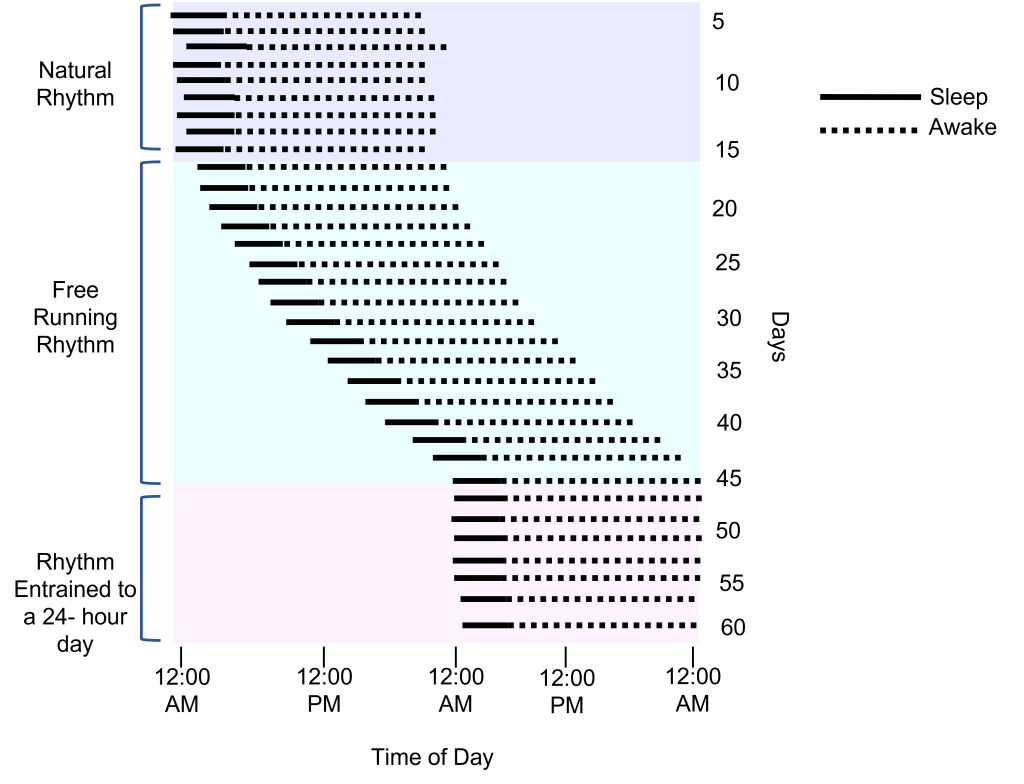57 Circadian Rhythms
Almost every living organism that we know of on Earth exhibits some sort of cyclic pattern of activity that closely matches the rising and setting of the sun.
Retinohypothalamic Tract
Our sleep and wake cycles are associated with the day/night cycle. Previously, we discussed the retinal ganglion cells that transmit signals from the rods and cones of the retina into the brain for processing within the lateral geniculate nucleus and primary visual cortex. A separate population of retinal ganglion cells do not process signals from the rods and cones, but rather serve as photoreceptors and are directly sensitive to light, communicating whether or not it is daytime.
These cells send their axonal projections separately from the optic nerve that sends most visual information. Rather, they project through a pathway called the retinohypothalamic tract, synapsing on a clump of cells in the hypothalamus called the suprachiasmatic nucleus (SCN). In turn, these cells of the SCN have projections to a gland in the brain called the pineal gland, so named for its pinecone-like shape. The pineal gland converts the amino acid tryptophan into melatonin, an endogenous hormone, which is then secreted into the bloodstream. Melatonin helps the brain regulate the sleep-wake cycle with increased melatonin levels helping to signal the body to prepare for sleep.
The production of melatonin is heavily dependent on exposure to sunlight. In the daytime, the SCN tonically inhibits activity of the pineal gland, resulting in low production of melatonin. But when daylight starts to decrease, the retinohypothalamic tract sends a weaker excitatory signal onto the SCN, which allows increased pineal gland activity. Light exposure is the main environmental influence that decreases melatonin levels.

Not all wavelengths of light are equally potent at dampening melatonin production. The shorter wavelengths of light, down in the violet-blue range, are much more efficient at activating the retinohypothalamic tract compared to longer, yellow-red wavelengths. Increased retinohypothalamic tract activation leads to decreased melatonin production, which can delay the onset of sleep. Fluorescent or LED lighting and digital devices, such as computer screens and cell phone screens, use blue wavelengths of light. Therefore, the best advice to optimize your sleep habits is to eliminate exposure to all digital devices about one hour before your intended bedtime.
Circadian Rhythms
The discovery of 24-hour patterns of behaviors began in 1729 with the French scientist Jean-Jacque d’Ortous de Mairan, who documented the movement of the Mimosa pudica plant. This unique organism was chosen since the plant exhibits heliotropism, light-seeking movements. In particular, this plant opened up the leaves in the daytime to capture sunlight, then closed at night, minimizing predation. When the plants were put into a dark room with no exposure to sunlight, to his surprise they still opened and closed their leaves in time with the clock. Mairan concluded that the plant did not change its behavior in response to light, but rather in response to some internal 24-hour clock. His work laid the foundations for future chronobiologists, scientists who study day-night dependent periodic phenomena in living beings.

Any behavior or physiological measure that intrinsically cycles on a 24-hour pattern is said to be a circadian rhythm. The word circadian comes from the Latin words ‘circa’ meaning “around”, and ‘diem’ meaning “day”. Compare this with an ultradian rhythm, any cycle that is faster than 24 hours, such as the cycling between deep sleep and REM sleep every 90 minutes. Alternatively, compare with infradian rhythms, patterns that are longer than 24 hours, like the 4-week-long human menstrual cycle.
Although we mostly think of the circadian rhythm in the context of sleep and wake, many other physiological measures fluctuate reliably throughout the day. Body temperature dips late in the evening, putting the body into a low-energy state that helps promote sleep. Withdrawal reflexes peak around midnight, hunger-driving hormone production rises before lunch and dinner, attention is usually highest in the morning—all manner of behaviors that rise and fall depending on the time of day can be said to be a part of a circadian rhythm.

Circadian Rhythms are Entrainable
Luckily, a person’s circadian rhythm is not permanent. Anyone who has traveled overseas to a different time zone for more than a few days has experienced that uncomfortable sensation called jet lag, where a person experiences psychological symptoms such as difficulty concentrating and mood swings, and physical symptoms like daytime fatigue, insomnia, and gastrointestinal distress (nausea, constipation, or diarrhea). Jet lag happens when there’s a mismatch between the internal environment and the signals that the brain receives from the outside world.
If you flew east from Chicago to Cairo, for example, your circadian clock will be off by 7 hours. When your internal “Chicago” clock is telling you to start getting sleepy around 11 PM, the sun will be rising in Cairo, as the locals are starting to wake up. You may be eating when you’re not hungry or laying down in bed when you’re not sleepy, and this mismatch contributes to jet lag. However, with a few days of adjustment, you will be able to overcome jet lag. You will start sleeping as the sun sets, you will get hungry at the same time as the Egyptians, and your physiological measures will start to align with your time zone.
This adjustment is only possible because our circadian rhythms are entrainable, meaning they are able to change and fit the surroundings. Our circadian rhythms entrain in response to zeitgebers, the German word for “time givers”: environmental cues, such as increased light exposure when the sun comes up, or social cues, such as increased sensory input from heightened activity of the people around you. A rise in the neurohormone melatonin is an important signal that contributes to helping the brain entrain, which is why taking a melatonin supplement late at night when in a new time zone may help someone get over jet lag more quickly.

If sunlight is a trigger that helps a person entrain their circadian rhythm to new environments, what would happen if a person is completely isolated from sunlight? In other words, what does a free-running circadian rhythm look like? One of the early documented case studies addressing this curiosity was conducted by a French cave explorer named Michel Siffre. In 1972, Siffre (voluntarily) spent six months deep in a Texan cave to evaluate what would happen to a person completely isolated from zeitgebers. At the end of the experiment, he found his circadian cycle was much longer than 24 hours, and very unpredictable—some of his so-called days would consist of being awake for 36 hours and asleep for 12.
A more rigorous scientific study, conducted in a group of people living in an underground bunker with unchanging lighting conditions for several days estimates the typical free-running circadian cycle to be close to 26 hours. In other words, a person absent from external cues begin to fall asleep and awaken 2 hours later each day. Free-running circadian disruption is a potential issue for scientists aboard the International Space Station, who experience about 16 sunsets and sunrises per day, since the orbiting space vessel completes one trip around the earth every 90 minutes. In order to minimize the negative effects of jet lag on the researchers aboard, NASA has the inside of the vessel set to an artificial 24-hour cycle. Bright blue LEDs illuminate the cockpit in the “daytime,” while dim, red-shifted wavelengths are used in the evening to induce sleepiness.
Key Takeaways
- The retinohypothalamic tract signals lighting conditions to the suprachiasmatic nucleus.
- Activity in the suprachiasmatic nucleus inhibits the pineal gland and production of melatonin.
- A 24-hour cycle is called a circadian rhythm
- Circadian rhythms are entrainable to zeitgebers, or external cues.
- Without zeitgebers circadian rhythms free-run, and will shift.
Attributions
Portions of this chapter were remixed and revised from the following sources:
- Open Neuroscience Initiative by Austin Lim. The original work is licensed under a Creative Commons Attribution-NonCommercial 4.0 International License.
Media Attributions
- Pineal gland and melatonin © Valerie Hedges is licensed under a CC BY-NC-SA (Attribution NonCommercial ShareAlike) license
- Circadian plant © Abubiju adapted by Valerie Hedges is licensed under a Public Domain license
- circadian rhythms © vaxzine is licensed under a CC BY-ND (Attribution NoDerivatives) license
- Free running rhythm © Valerie Hedges is licensed under a CC BY-NC-SA (Attribution NonCommercial ShareAlike) license
Projection of light-sensitive retinal ganglion cells that signals to the suprachiasmatic nucleus
endogenous hormone secreted by the pineal gland
movements dependent on light
scientists who study day-night dependent periodic phenomena in living beings
physiological measures that intrinsically cycles on a 24-hour pattern
any cyle that is faster than 24 hours
patterns that are longer than 24 hours
able to change to fit surroundings

